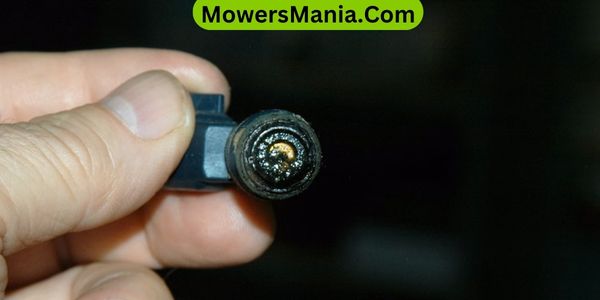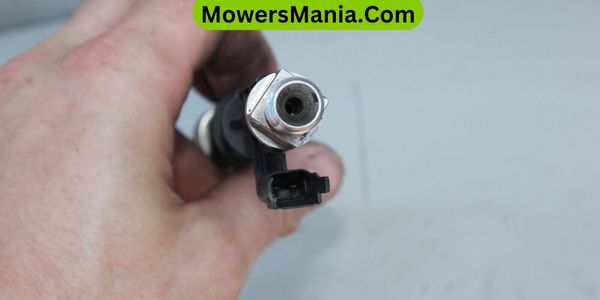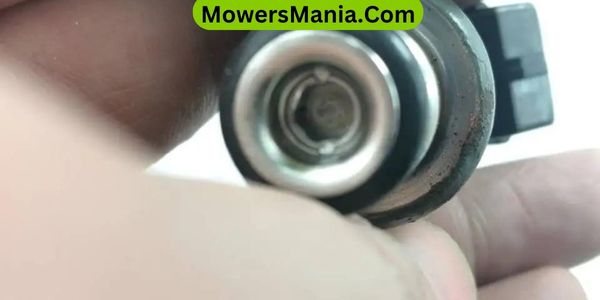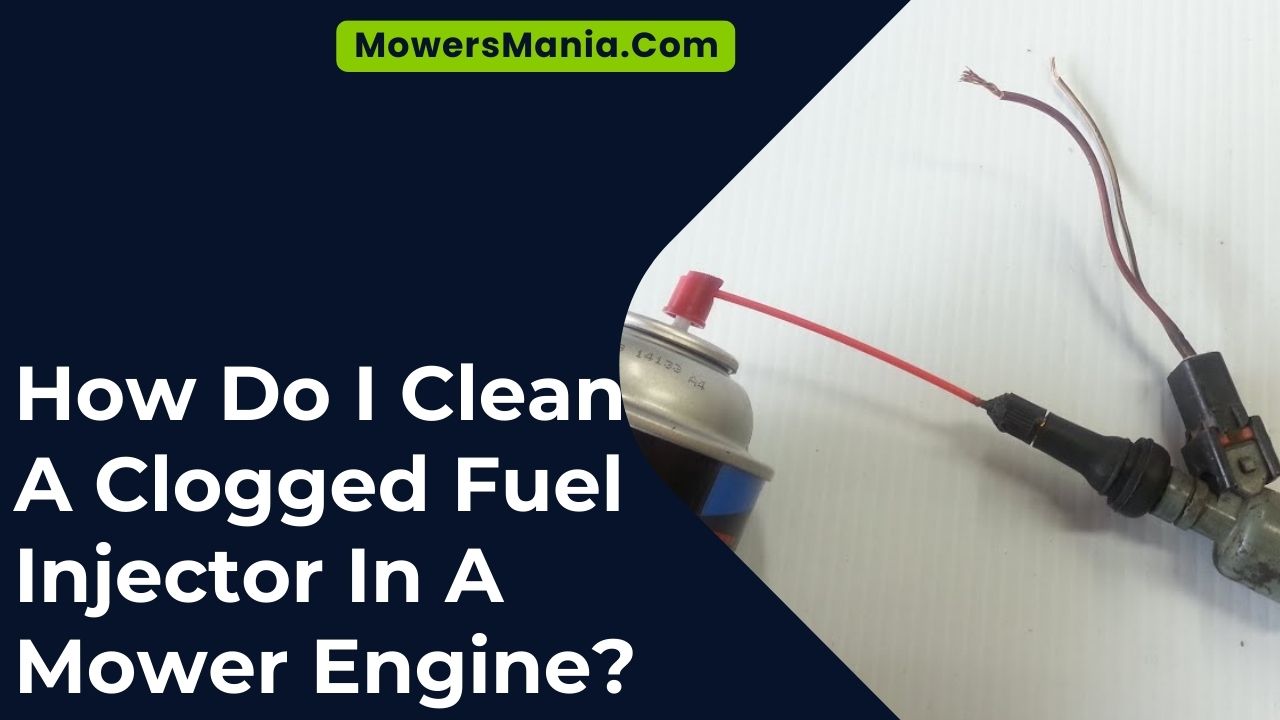You know the saying, ‘An ounce of prevention is worth a pound of cure’? Well, when it comes to keeping your mower engine running smoothly, this couldn’t be more true.
But if you find yourself facing a clogged fuel injector, don’t fret just yet. There are some simple steps you can take to tackle this issue and get your mower back in top shape.

Let’s walk through the process of cleaning a clogged fuel injector in a mower engine, so you can get back to tackling your lawn with ease.
Symptoms of a Clogged Fuel Injector
If your mower engine is experiencing a loss of power, rough idling, or misfiring, these could be symptoms of a clogged fuel injector.
When your engine lacks power, you may notice a decrease in its ability to perform tasks, such as mowing through thick grass.
Rough idling can manifest as a shaky or unstable engine while it’s running, and misfiring can cause the engine to sound like it’s stumbling or coughing.
Additionally, you might observe a decrease in fuel efficiency, as the clogged injector disrupts the proper fuel-to-air ratio, resulting in poor combustion.
Another sign of a clogged fuel injector is a strong gasoline smell emanating from the mower, indicating that the fuel isn’t burning efficiently.
Furthermore, you might experience difficulty starting the engine or notice black smoke coming from the exhaust due to the excessive fuel being injected.
If these symptoms are present, it’s important to address the issue promptly to prevent further damage and ensure optimal performance of your mower engine.
Tools and Materials Needed
You’ll need a few specific tools and materials to effectively clean a clogged fuel injector in your mower engine.
It’s essential to have the right cleaning solution and safety gear to protect yourself during the process.
Let’s go over the necessary tools and materials to get the job done efficiently and safely.
Required Tools
To clean a clogged fuel injector in a mower engine, gather the following tools and materials.
- Fuel injector cleaning kit, which typically includes a cleaning solution and attachments for connecting to the fuel system.
- Socket set or wrench to remove the fuel injector from the mower engine.
- Safety gloves and goggles to protect your hands and eyes from the cleaning solution and any fuel that may spill during the process.
- Lint-free cloths or paper towels for cleaning up any spills or excess cleaning solution.
- Fuel injector tester to ensure that the injector is functioning properly after cleaning.
With these tools and materials, you’ll be well-equipped to effectively clean a clogged fuel injector in your mower engine.
Cleaning Solution
You need a high-quality fuel injector cleaning solution that’s compatible with your mower engine to effectively clean the clogged fuel injector.
Look for a cleaning solution specifically designed for small engines to ensure optimal performance. Avoid using generic automotive fuel injector cleaners, as they may not be suitable for mower engines.
When choosing a cleaning solution, consider factors such as the type of fuel your mower uses and any specific manufacturer recommendations.
It’s crucial to follow the manufacturer’s instructions when using the cleaning solution to prevent any damage to the engine.
Additionally, make sure to wear protective gloves and eyewear when handling the cleaning solution, as it can be harmful if it comes into contact with your skin or eyes.
Safety Precautions
For safety precautions, ensure you have the necessary tools and materials readily available before starting the cleaning process.
Here’s what you’ll need:
- Tools and Equipment:
- Safety goggles: Protect your eyes from any potential splashes or fumes during the cleaning process.
- Wrench or socket set: Use this to disconnect the fuel injector from the mower engine with ease.
- Materials:
- Cleaning solution: Have the appropriate fuel injector cleaning solution on hand to effectively dissolve any clogs.
- Clean cloth or paper towels: Use these to wipe any excess cleaning solution and ensure a tidy work area.
Having these tools and materials at your disposal will help ensure a safe and efficient cleaning process for your mower engine’s fuel injector.
Removing the Fuel Injector
Carefully disconnect the fuel injector from the engine, ensuring that you follow the manufacturer’s guidelines to avoid damaging the components. Start by locating the fuel injector, which is typically attached to the fuel rail.
Before removing the injector, relieve the fuel system pressure by following the specific instructions in your mower’s manual. Once the pressure is released, use a wrench to carefully loosen the fuel injector’s mounting bolts.
Gently wiggle the injector to detach it from the fuel rail. Be cautious not to damage the injector or the surrounding components during this process.
After removing the fuel injector, inspect it for any signs of damage, corrosion, or clogging. If there are visible contaminants, it may be necessary to clean or replace the injector.
When handling the fuel injector, avoid touching the sensitive nozzle or internal components to prevent potential damage.
Remember to label the injector and its corresponding components to ensure proper reinstallation. Additionally, take note of any seals or O-rings that may need replacement. Properly storing the fuel injector during the cleaning process is crucial to prevent further damage.
Cleaning the Fuel Injector

To clean the fuel injector, you can use solvents or a fuel additive. This will help dissolve any deposits or clogs that may be affecting the injector’s performance.
Cleaning With Solvents
You can effectively clean the clogged fuel injector in your mower engine using a specialized solvent designed for this purpose.
Here’s how:
- First, obtain a fuel injector cleaning kit, which typically includes a pressurized canister of cleaning solvent and a hose attachment.
- The kit may also contain a user manual with specific instructions for your mower’s fuel injector system.
- Next, connect the hose from the cleaning kit to the fuel injector and follow the kit’s instructions to introduce the solvent into the injector.
- Typically, this involves running the engine with the cleaning solvent to allow it to clear out any deposits or debris clogging the injector.
Using a Fuel Additive
How can a fuel additive effectively clean a clogged fuel injector in a mower engine?
Using a fuel additive is a simple and effective way to clean a clogged fuel injector. When choosing a fuel additive, look for one specifically designed to clean fuel injectors and remove deposits.
Add the recommended amount of the fuel additive to your mower’s fuel tank, then fill the tank with fresh gasoline.
Run the engine for a few minutes to allow the additive to circulate through the fuel system and clean the clogged injector.
The cleaning agents in the additive will help dissolve and remove the built-up deposits, restoring proper fuel flow and injector function.
Regular use of a fuel additive can also help prevent future clogs and maintain optimal engine performance.
Reinstalling the Fuel Injector
After cleaning the fuel injector, carefully position it back into place in the mower engine, ensuring that it’s securely seated and the connections are properly aligned.
Here’s how to reinstall the fuel injector:
- Positioning the Injector
- Gently place the cleaned fuel injector into its designated slot in the engine, ensuring that it fits snugly and securely.
- Make sure that the O-rings are in good condition and properly seated to prevent any fuel leaks.
- Securing the Connections
- Attach the electrical connector to the fuel injector, ensuring that it clicks into place securely.
- Double-check that all connections are properly aligned and securely fastened to prevent any fuel or air leaks.
When reinstalling the fuel injector, it’s crucial to handle it with care to avoid any damage to the delicate components. Ensure that you follow the manufacturer’s guidelines and torque specifications when securing the injector to prevent any issues with fuel delivery.
Once the fuel injector is securely reinstalled, you can proceed with reconnecting any other components that were removed during the cleaning process and start the mower engine to ensure proper operation.
Testing the Mower Engine

Once the fuel injector is securely reinstalled, the next step is to test the mower engine for proper operation and fuel delivery. Start by ensuring that the fuel lines are properly connected and there are no leaks.
Then, turn the engine on and let it run for a few minutes. Pay close attention to any signs of rough idling, sputtering, or stalling, as these could indicate ongoing issues with fuel delivery.
If the engine runs smoothly, engage the blades to put it under load. Observe if the engine maintains a consistent and strong power output without any hesitation or loss of performance.
Additionally, you can use a fuel pressure gauge to measure the pressure at the fuel injector and ensure that it falls within the manufacturer’s specified range.
If the engine exhibits any of the previous symptoms or if the fuel pressure is outside the acceptable range, further diagnosis and potential maintenance may be required.
Testing the mower engine after cleaning a clogged fuel injector is essential to ensure that it’s functioning optimally and delivering the right amount of fuel for efficient operation.
Frequently Asked Questions [FAQs]
Can I Use a Different Cleaning Solution Other Than Fuel Injector Cleaner to Clean a Clogged Fuel Injector in a Mower Engine?
You can try using a different cleaning solution for a clogged fuel injector in a mower engine, but make sure it’s safe for fuel systems. Consult the manufacturer’s recommendations or a professional for the best option.
How Often Should I Clean the Fuel Injector in My Mower Engine to Prevent Clogging?
You should clean the fuel injector in your mower engine every 100 hours of operation to prevent clogging. Regular maintenance helps avoid performance issues and extend the life of your equipment.
Is It Necessary to Replace the Fuel Injector if It Is Severely Clogged and Cleaning Does Not Work?
If the fuel injector is severely clogged and cleaning doesn’t work, it’s necessary to replace it. Continued use of a severely clogged injector can lead to engine performance issues and potential damage.
Can a Clogged Fuel Injector Cause Other Issues With the Mower Engine, Such as Starting Problems or Poor Performance?
If a clogged fuel injector is causing starting problems or poor performance in your mower engine, it could be affecting fuel delivery. Addressing this issue by cleaning or replacing the injector may improve engine performance.
Are There Any Specific Maintenance Tips to Prevent Fuel Injector Clogging in a Mower Engine?
To prevent fuel injector clogging in a mower engine, use high-quality fuel, add a fuel injector cleaner to the gas tank regularly, and keep up with routine maintenance. Following these tips can help maintain optimal engine performance.
Conclusion
Now that you’ve cleaned the clogged fuel injector in your mower engine, you should notice improved engine performance and efficiency.
Regular maintenance and cleaning of the fuel injector will help keep your mower running smoothly and prevent future clogs.
Remember to follow the manufacturer’s guidelines for maintenance and always use the appropriate tools and materials to ensure the best results.
Happy mowing!



